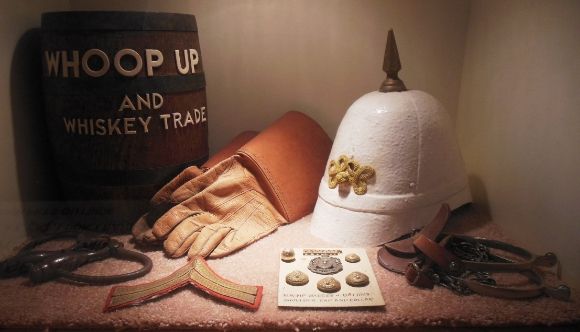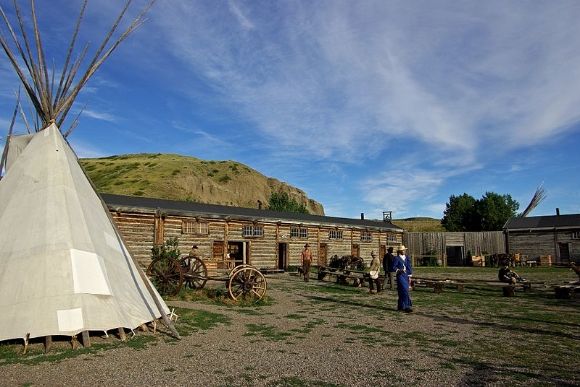
In spite of the opposition of fur traders, in 1832 Congress passed a law stating:
“No ardent spirits shall be hereafter introduced, under any pretence, into the Indian country.”
This total prohibition applied to traders and non-traders and allowed no exception. While it was clear that the law totally banned all alcohol on reservations, this was generally overlooked while negotiating treaties (American officials felt that intoxicated Indians were more likely to sign treaties) and enforcement among fur and hide traders was less than perfect.
For American traders, alcohol was the perfect product for the Indian market: in was consumable and addictive, therefore it was in high demand. The profit margins were outstanding. While the traders often feared drunken Indians, particularly the Blackfoot, they also recognized that it was easier to swindle Indians who were intoxicated. In 1869, the American traders came up with a scheme to evade U.S. law which prohibited from selling alcohol to the Indians: they simply moved across the border into Canada. While the sale of alcohol to Indians was also illegal in Canada, the lack of non-Indian settlement in Alberta meant that there was no effective law enforcement in the area. Here they could continue to think of themselves as law-abiding American citizens in spite of the fact that they were violating numerous Canadian laws.
American traders from Fort Benton, Montana established Fort Hamilton near present-day Lethbridge, Alberta in 1869. The fort was named after the mercantile firm of Hamilton, Healy and Company. The traders, under the command of John Healy, numbered about 20 well-armed men. The establishment of this fort, which quickly became known as Fort Whoop-Up, marked the beginning of an illegal international trade in alcohol to the Indians, particularly the Blackfoot. With this trade, the American traders became very wealthy and the Indians suffered social and mental degradation.
Whoop-Up Bug Juice was one of the kinds of alcohol sold to the Indians. This was created by spiking the alcohol with ginger, molasses, and red pepper. To provide color, black chewing tobacco was added.
Soon there were many “forts”, hastily and crudely constructed trading posts providing Indians with alcohol and rifles in exchange for horses (many liberated from both non-Indians and Indians), buffalo hides, and booty taken from raids on non-Indians attempting to pass through Montana. The “forts” were usually surrounded by a palisade of sharpened logs. Some of the “forts” arrogantly flew the American flag. The trail north across the Canadian border was soon known as the Whoop-Up Trail and the area just north of the boundary in present-day Alberta was known as Whoop-Up Country.
In 1870, Canadian Prime Minister John A. Macdonald received a letter from Hamilton Fish, the United States Secretary of State, complaining about the Blackfoot. According to Fish, Blackfoot raiding parties were crossing into Montana to steal horses and murder Americans. They would then return to Canada where they would sell their stolen horses for rifles, ammunition, and whiskey. Since the Hudson’s Bay Company did not sell alcohol to Indians, it was apparent to authorities on both sides of the border that American traders had moved north of the border.
The following year, the Canadians sent Lieutenant William F. Butler to investigate the allegations of illegal whiskey trade. He travelled 2,700 miles in 119 days. He reported that the American whiskey traders operating just north of the border were a disruptive influence. The American traders were using alcohol to obtain furs and hides from the Indians, a practice prohibited in the region. In addition, they were actively trying to turn the Natives against the Hudson’s Bay Company by suggesting that the company traders were cheating them.
Butler estimated that there were about 18,000 Natives in the region, including 2,000 Métis. Hostile relations between the Blackfoot and the Cree were a concern and this was being exacerbated by the alcohol trade.
In 1872, Colonel Patrick Robertson-Ross completed a fact-finding mission regarding the illegal trade in whiskey in Alberta. He reported:
“It appears that for some time they have carried on an extensive trade with the Blackfoot Indians, supplying them with rifles, revolvers, whiskey, and other ardent spirits; in direct opposition to the laws of both the United States and the Dominion of Canada, and without paying customs duties for the goods introduced into Canada.”
During 1871-1872, 88 Blackfoot in Alberta were murdered in drunken brawls among themselves. These brawls were fueled by the illegal whiskey forts on the Whoop-Up Trail.
In response to the lawlessness and violence stemming from the illegal alcohol trade, the North West Mounted Police were formed in 1873 to administer law and order in the Northwest Territories. The Mounties, as they came to be called, used consultation and negotiation to avert conflict rather than to seek it. The Mounties sought fairness in their dealings with the tribes.
In 1874, the North West Mounted Police arrived at Fort Whoop-Up. The fort had a stockade of rough logs and its defenses included two brass canons. The flag flying over the fort bore some resemblance to the American flag, but was in fact a company flag. James Macleod, Assistant Commissioner of the North West Mounted Police, met with the fort’s caretaker who informed him that all of the traders had gone south for the winter. The caretaker insisted that no alcohol was traded from the fort. Macleod then informed him that no alcohol sales would be permitted.
The North West Mounted Police learned from Three Bulls about the location of some whiskey traders. The Mounties found two wagons with cases of alcohol. They confiscated all of the goods, including horses, rifles, pistols, and buffalo robes.
James Macleod soon reported:
“I am happy to be able to report the complete stoppage of the whiskey trade throughout the whole section of this country, and that the drunken riots, which in former years were almost of a daily occurrence are now entirely at an end; in fact, a more peaceable community than this, with very large numbers of Indians camped along the river, could not be found anywhere.”
With the alcohol sale halted, the tribes in the area were able to replace their depleted horse herds and restore order over their lives.

Fort Whoop-Up National Historic Site is shown above.
Leave a Reply